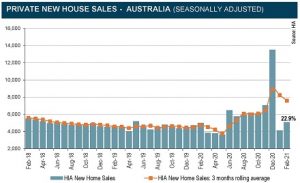 New Home Sales increased in February to be 1.7 per cent higher than February last year, prior to the impact of COVID restrictions on new home sales. Source: Timberbiz
New Home Sales increased in February to be 1.7 per cent higher than February last year, prior to the impact of COVID restrictions on new home sales. Source: Timberbiz
The HIA New Home Sales report – a monthly survey of the largest volume home builders in the five largest states – is a leading indicator of future detached home construction.
“Sales in the three months to February 2021 were higher by 60.5 per cent than in the same three months the previous year,” HIA economist, Angela Lillicrap said.
This strong result reflected the significant impact of HomeBuilder on demand for detached housing.
“HomeBuilder was the catalyst for improving consumer confidence in the housing market,” she said.
“A surge in sales was observed following the announcement of HomeBuilder in June 2020, which lead to strong sales through to the end of 2020.”
Ms Lillicrap said that in December 2020, there had been a near-record volume of new home sales as households rushed to finalise contracts to build a new home before the end of the $25,000 grant.
She said the full impact of the extension of the HomeBuilder grant, at a value of $15,000, will not be observed until the end of March.
To receive the HomeBuilder grant, construction is required to begin within six months of signing a contract to build. As a consequence, it is possible that builders will delay the signing of some contracts to allow for greater flexibility and more detailed planning of projects.
“For this reason we expect a surge in sales in March. Due to the lower grant offering, this surge will not be as large as the December 2020 surge,” Ms Lillicrap said.
“Record low interest rates and rising house prices are sustaining market confidence into 2021. This strong level of consumer confidence combined with the demographic shift to regional areas is driving ongoing demand for new detached homes.”
Sales in the three months February 2021 increased across all jurisdictions compared to the same time the previous year. South Australia is up by 149.7 per cent, followed by Victoria (+69.1 per cent) and Queensland (+60.4 per cent). New South Wales increased by 46.2 per cent and Western Australia is up by 25.1 per cent over the same period.





